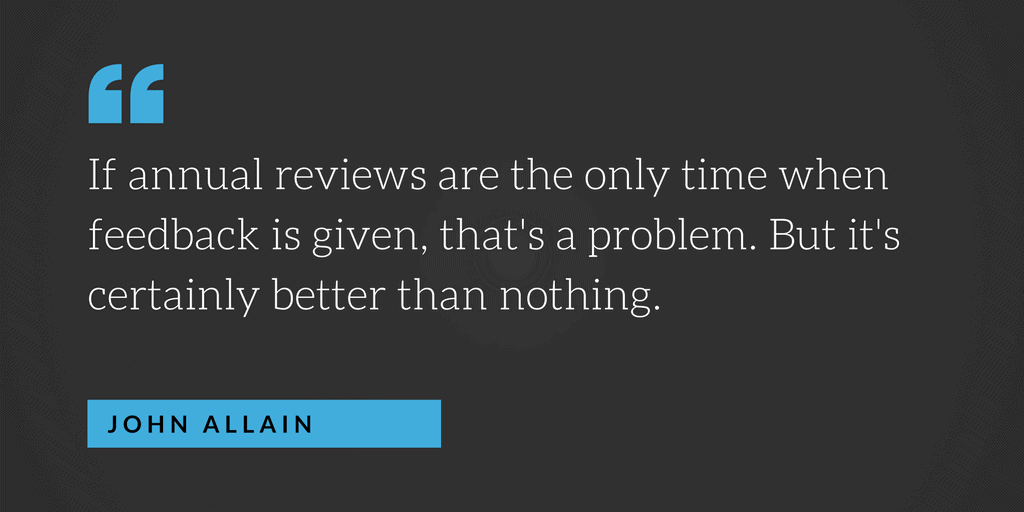Kim Scott is the author of Radical Candor: Be a Kick-Ass Boss Without Losing Your Humanity and Radical…
How to Improve, Not Kill the Annual Performance Review
Q4 will be over before you know it, and you know what that means for so many companies: it’s performance review time!
For some of you, you’re groaning and shaking your heads — wishing you didn’t have to go through this burdensome process. Others are feeling relieved because your company has done away with formal performance reviews. We all know that the Performance Review gets a bad rap, but are they all bad?
The Movement Against Performance Reviews
There’s an interesting trend of companies starting to abandon the semi-annual or annual formal performance review process. GE, who has been recognized in the industry as a pioneer of formal performance review processes, is also leading the way in re-evaluating the approach. Experts and surveys have reported that annual performance reviews are time-consuming (and therefore expensive) and don’t work for achieving great performance across a company. Many companies are questioning and scrapping their annual review process in favor of more frequent, continuous feedback.
Why to Keep Performance Reviews
We’re all about impromptu feedback, but jettisoning formal performance management processes isn’t always necessary or a good choice for every company. So many companies, as a part of the formal process, use a numerical rating to help distribute scarce resources, such as pay increases, promotions, and stock grants. The process of scoring people and calibrating those scores among managers within larger organizations is absolutely imperfect, but it is the best I’ve seen at helping leadership make fair and equitable decisions about the distribution of scarce resources. If you were to jettison your performance management system altogether, you would need to do something to replace this process, and that can be tricky and time consuming.
Another reason to hang on the performance reviews is that a company can be assured that at least a couple times per year everyone in the enterprise is getting some kind of feedback. It’s almost like a top-down quality control step. That feedback might be uneven, might suffer from the issues I mention below, but at least there is some kind of evaluation happening. “If this is all you have happening, that’s a problem, but it’s certainly better than nothing,” says John Allain, a forward-thinking Director of HR at Continental Properties Company.

It’s possible to neutralize some of the problems with semi-annual/annual performance management processes without abandoning them completely. Instead of getting rid of performance reviews, some companies may want to focus on adjusting their processes to achieve a better outcome.
Solving Key Problems with Performance Reviews
Because we at Candor believe that feedback is a crucial part of success for managers and teams, I’m going to focus on some of the feedback process issues that performance reviews introduce. If you are aware of these issues and some ways to solve them, you can undo the damage that the annual performance review has on your feedback processes.
Problem 1: Recency bias
Review cycles are designed to be 6 months or 12 month review periods, but very often the feedback is heavily focused on the last 6 weeks or so. This isn’t crazy, but can feel unfair to employees who feel like that had a big achievement way back in the review period.
The Solve: Themes
Think about the formal review process as a chance to tease out persistent themes for both Strengths and Areas for Development. Think about the Situation, Behavior, and Impact model for feedback and recurring patterns based on examples from the review period.
To help generate these themes, it can be helpful to take notes throughout the review period that you can reference to remind yourself what was happening and avoid the emphasis on the most recent several weeks. In addition, when putting together the review, review your calendar and create a list of key accomplishments. It’s not easy, but it’s a way to control for recency bias.
Use the examples and themes from the performance review to serve as context for more frequent feedback on an ongoing basis.
Problem 2: The Save Up
Saving feedback over the review period in order to deliver it all together during the review is problematic for a number of reasons. Getting feedback on specific things that happened potentially as far back as 11 months ago doesn’t feel particularly useful or fair to employees, especially if the feedback is in any way adverse. Also, feedback that you save up tends to be less clear because the details and context are no longer fresh for either of you. I had a girlfriend in high school who like to remind me of things I did or said 6 months earlier — I rarely remembered what she was talking about, and all I could think was:

The Solve: Immediate, impromptu feedback
Make feedback more like brushing and flossing and less like a root canal. STOP SAVING UP YOUR FEEDBACK. We have to stop making the formal performance management review this big, scary, anxiety-inducing exercise. Feedback delivered in the formal review should never be a surprise. Instead of unfairly surprising people, start giving feedback in 1-3 minute bursts, immediately following the feedback-able event, and create a culture where feedback is the norm.

And then, like mentioned above, the performance review can be a time to summarize the themes of the impromptu feedback that you’ve given over the course of the review period. You and your employee can check in on progress made in those areas and where to continue focusing.
Problem 3: Manager feedback
In many formal reviews, managers take time to ask, “Do you have any feedback for me?” I’m not a fan of this practice, mostly because I don’t think the employee’s review is the appropriate venue for this. It’s their review, not yours. The question also risks feeling like a lightweight manipulation, similar to the feedback sandwich. It can come across as the manager trying to make the employee comfortable, not really to solicit the employee’s feedback.
The Solve: Ask for feedback frequently
It’s ***great*** that you want to get feedback from your employees. You should absolutely ask them what you can do to make it easier for them to work with you, but don’t do that in your employee’s performance review! Just like you won’t save up feedback for your employee for the performance review, encourage them to give you impromptu feedback. Review our handy, Andy Grove-inspired process for getting feedback, and commit to doing this on a regular basis — in your 1:1, for example.
You should also make sure to regularly ask for feedback on your feedback. You’re giving frequent praise to help people know what to do more of and criticism to help people know what to do better, so it’s critical to understand how your feedback is landing for them. We recommend asking people to gauge your feedback regularly throughout the review process – not trying to squeeze this into the semi-annual review of your employee. You can use our product for this (stay tuned for v2!).
Problem 4: Prescription only
Managers often think they are expected to have all the answers in a performance review, that it’s their job to come in with everything figured out. This tends to lead to managers approaching performance reviews not with humility but as a way to deliver the prescription for improvement. And according to John Foster, Head of Talent and Chief Wellness Officer for Thrive Market, “‘You could be more effective if you fixed X’ sets you up as the ‘judge and jury’ and sets up your employee as a passive recipient. This can lead to instant rejection or simple resistance which means the feedback has no effect.”
The Solve: Discussion mindset
Managers who approach feedback (and performance reviews) as a discussion rather than a prescription will be able to offer direct challenges while also showing that they care personally. John suggests using a question like “What do you think went really well?” or “What did you learn during this last few months?” as a way to start a constructive discussion. This allows managers and employees to work together to solve problems, and as John says, “It makes the manager more of a coach and partner in the process and will more likely lead to performance improvements. Ultimately, you want your team to be curious and drive the conversation from their perspective versus having you be the one to ‘let them know’ what didn’t go well.”
So, to wrap up — the current approach to performance reviews is far from perfect. There are some key flaws with how they have influenced feedback processes in most companies. But if you’re aware of these imperfections and avoid common mistakes, hopefully you can maintain a great feedback culture and make performance review season a bit more enjoyable!
What do you think? Can performance reviews be adjusted and saved, or should they be thrown out completely?



